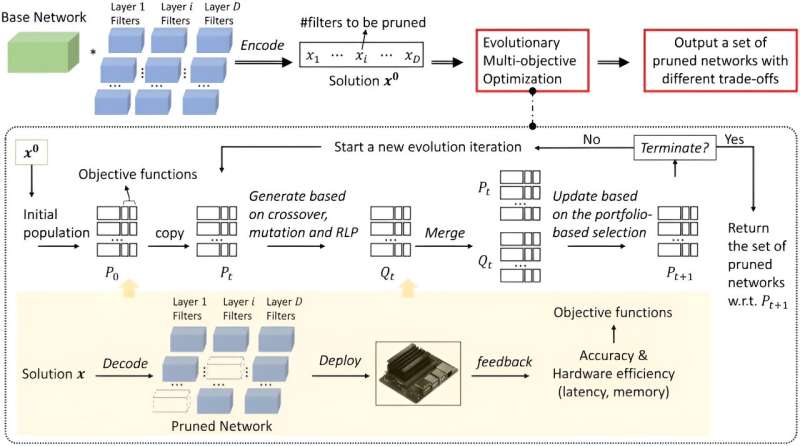
September 23, 2024 by KeAi Communications Co.
Collected at: https://techxplore.com/news/2024-09-pruning-approach-neural-network-optimized.html
Neural network pruning is a key technique for deploying artificial intelligence (AI) models based on deep neural networks (DNNs) on resource-constrained platforms, such as mobile devices. However, hardware conditions and resource availability vary greatly across different platforms, making it essential to design pruned models optimally suited to specific hardware configurations.
Hardware-aware neural network pruning offers an effective way to automate this process, but it requires balancing multiple conflicting objectives, such as network accuracy, inference latency, and memory usage, that traditional mathematical methods struggle to solve.
In a study published in the journal Fundamental Research, a group of researchers from Shenzhen, China, present a novel hardware-aware neural network pruning approach based on multi-objective evolutionary optimization.
“We propose to employ Multi-Objective Evolutionary Algorithms (MOEAs) to solve the hardware neural network pruning problem,” says Ke Tang, senior and corresponding author of the study.
Compared with conventional optimization algorithms, MOEAs have two advantages in tackling this problem. One is that MOEAs do not require particular assumptions like differentiability or continuity, and possess strong capacity for black-box optimization. The other is their ability to find multiple Pareto-optimal solutions in a single simulation run, which is very useful in practice because it offers flexibility to meet different user requirements.
“Specifically, once such a set of solutions has been found, end users can easily choose their preferred configurations of DNN compression, such as latency first or memory consumption first, with just one click on the corresponding solutions,” adds Tang.
The team’s findings further revealed that while multi-objective evolutionary algorithms hold significant potential, they still struggle with low search efficiency. To that end, the researchers developed a new MOEA, namely Hardware-Aware Multi-objective evolutionary network Pruning (HAMP), to address this issue.
“It is a memetic MOEA that combines an efficient portfolio-based selection and a surrogate-assist local search operator. HAMP is currently the only network pruning approach that can effectively handle multiple hardware direct feedback and accuracy simultaneously,” explains first author Wenjing Hong. “Experimental studies on the mobile NVIDIA Jetson Nano demonstrate the effectiveness of HAMP over the state-of-the-art and the potential of MOEAs for hardware-aware network pruning.”
The team’s results show that HAMP not only manages to achieve solutions that are better on all objectives, but also simultaneously delivers a set of alternative solutions.
“These solutions present different trade-offs between latency, memory consumption, and accuracy, and hence can facilitate a rapid deployment of DNNs in practice,” concludes Hong.
More information: Wenjing Hong et al, Multi‐objective evolutionary optimization for hardware‐aware neural network pruning, Fundamental Research (2024). DOI: 10.1016/j.fmre.2022.07.013

Leave a Reply